Two weeks in Greece – Itinerary
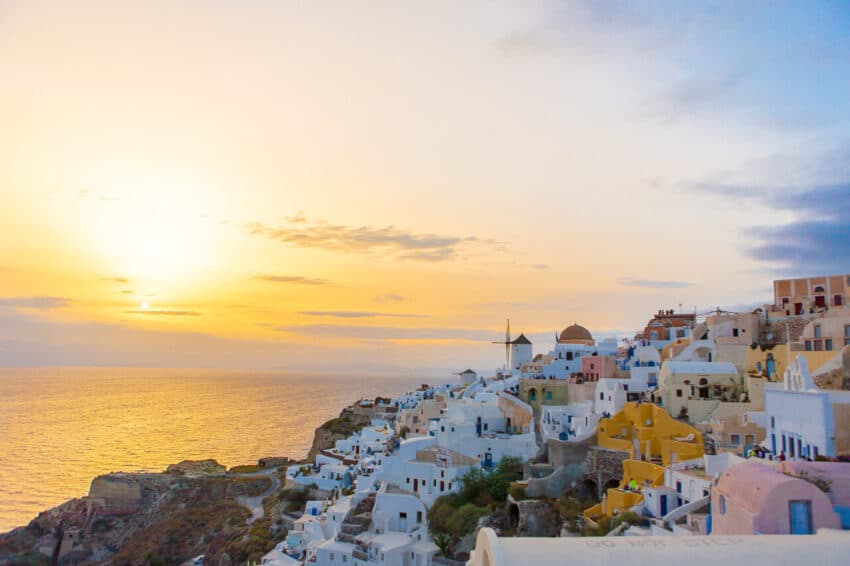
Greece is one of our favourite destinations. Take a walk through history, gape at gorgeous landscapes at every turn, soak up the sun by the breathtaking Aegean coastline, there is so much to see and do. Our two week Greece itinerary combines Greece’s most iconic spots and must-not miss sights, with plenty of time to unwind on the Greek islands and enjoy Greece’s rustic, laid-back charm.
Duration: 14 days
Traveled as: a couple
Type of travel: pleasure
Combined with other destinations: no
In this post, I wrote about why Greece has always been a dream destination. Our trip was carefully researched in order to take in everything Greece has to offer. We traveled as a couple without kids, but Greece really has something for every kind of traveler. It’s a great backpacking destination, has plenty of romantic charm, and is such a kid-friendly country I would take the littles back in a heartbeat.
The best time to see Greece
This may sound cheesy, but there is no bad time to visit Greece. Even in the winter, average temperatures are still mild – around 10 degrees Celsius – and perfectly comfortable for sightseeing. It may be a little wetter (average 11 days of rain in December compared to 1 day of rain in July). Traveling to Greece during winter and shoulder season (Oct, Nov, Mar, Apr) means it will be a lot more affordable and a lot less crowded. However, some venues and hotels do close for the winter, so it is always a good idea to check ahead of time. With that being said, many popular hotels on the Greek islands will get booked 6-8 months in advance, so *definitely* check ahead of time.
The most popular times to visit Greece are May through September. July and August are the hottest months (average max 31-32 degrees C) and the beaches and Greek islands will be the most crowded. We visited at the end of May/beginning of June. May and June are quieter but still warm (think t-shirt and dresses). June is definitely warm enough to hit the beach right before high season. September might be the most ideal. The water was still a bit chilly in June, but it warms significantly over the summer.
The best way to get around Greece
The majority of flights will arrive in Athens, Greece’s capital. You can also fly directly to some of the larger Greek islands. But even if the islands are your only stop, this will be far more expensive (at least from North America) than flying into Athens and taking a ferry to the islands.
Hands down, I recommend renting a car to get around mainland Greece. The country does have a public transit system, but the trains are not as reliable and do not run nearly as frequently as Western European countries. It is possible to base your stay in Athens, and join day trips via bus to popular sightseeing spots such as Delphi or Olympia. If you’re staying in Athens and visiting Meteora in Central Greece, there is a convenient train that will get you there.
BUT. Renting a car in Greece will allow you to make stops between destinations (for example, Mycenae between Athens and Nafplio). Driving will also take you down (and up!) some incredible roads. It will take you to quaint little towns and allow you to soak in all the charm Greece has to offer. Our most memorable drive was from Nafplio to Olympia, weaving through the mountains and coming across small rural villages. The roads were so winding we got stuck behind a truck which couldn’t get around a bend in one of the villages. It required the villagers to help physically realign the front wheels!
Another benefit of driving is you get more flexibility to visit the must-see spots off peak hours. We were able to visit Ancient Olympia in the late afternoon, after all of the tour buses had departed for the day. We had the entire grounds almost to ourselves.
For hopping between the Greek Islands, you do NOT need a car. There is a convenient bus that runs between Athens and Port Piraeus, where the island ferries dock. On the islands themselves, you can opt to take a bus or taxi, or rent a car or even a dune buggy for the day.
Our 14 day itinerary
Day 1: Athens
Fly into Athens.
Most of the popular sights in Athens are in the city centre and clustered around the Acropolis. You do not need a car (in fact, I strongly recommend against renting one for city driving.) For convenience, I would pick a hotel or airbnb near the city centre. We stayed at an airbnb just a stone’s throw away from the pedestrian street under the acropolis. We were not planning to luxuriate in our room, and chose our accommodations solely based on proximity. If you stay in an airbnb, you don’t need an extensive kitchen, as there are any number of restaurants and patios in the area.
You will need to make your way from the airport into the city, which is about half an hour away. You can take a private airport taxi, but if you’re staying in the city centre, both the metro and bus will get you there for much cheaper. We took the bus. There are two easily accessible bus lines from the airport. One goes into the city centre and the other directly to Piraeus, the gateway port to the Greek islands.
Once you settle into your accommodations and get a chance to freshen up (we took a nap), it’s time to get out and see some sights. How much time do you need to spend in Athens? To hit the main sites, I would say a day and a half, no more than two. Athens is not a beautiful city, and not a place to linger if you’re looking to enjoy classic Greek charm. (When we were planning for our trip, we read Rick Steve’s Greece, who very explicitly told us to get in, see the sights, and get out again.)
You can do the main sites in any order. We hit up the Acropolis in the late afternoon, when it was a little cooler. The Acropolis is home to the fabled Parthenon, dedicated to the Goddess Athena, and has a number of other ruins. You also get a fantastic birds-eye view of Athens from the top of the Acropolis.

At night, watch moon-rise from Mars Hill. Here, you get a front row seat of the Acropolis, beautifully floodlit at night.
Day 2
For the second day in Athens, split your day between exploring the Greek Agora (basically what used to be ancient Greece’s downtown, where anyone who was anyone hung out), and the National Archeological Museum. The National Archeological Museum is the only main attraction not in the downtown core, but easily accessible by bus or taxi.
On your way back from the Greek Agora, take a walk through Plaka, a pedestrian square filled with tourist shops and cafes (much like a bazaar in other cities).
For the evening, enjoy a stroll along the pedestrian path under the Acropolis. Rather quiet and deserted in the heat of the day, it comes alive with performers and street music, food stands, and sellers peddling toys and souvenirs.
The only main attraction we opted not to see was the Acropolis museum, dedicated to artifacts found on the Acropolis. After the National Archeological Museum, it was just one too many artifact museums for us. If there is interest, it could easily be combined with your visit of the Acropolis.
Day 3 – Peloponnese
Pick up your rental (most large rental companies have locations in Athens city centre), head out of Athens toward Nafplio.
The Peloponnese is the peninsula south of Athens. Here you will find historical sites against the backdrop of some fabulous scenery. This is also where you will find that laid-back Greek charm. The rail system is non existent in this part of the country. If you are not renting a car, you will need to take a bus. Unfortunately, at least at the time we went, the schedules were not always available or accurate.
It is about a two-hour drive from Athens to Nafplio. Along the way, stop at the ruins that was once the palace and city of Mycenae. Mycenae was built atop a hill, and the surrounding countryside views are spectacular.
Then, I recommend driving straight to Nafplio, a charming little seaside town nestled under a cliff. We booked the quaintest hotel here (Pension Anapli), and made sandwiches for lunch while we people-watched and admired the view from our balcony.
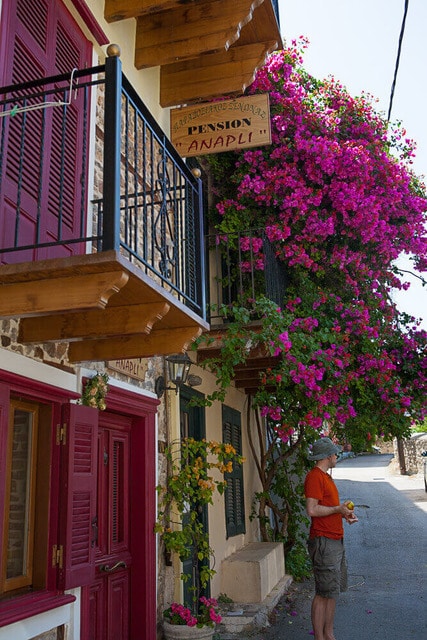
In the afternoon, visit Epidavros, a historical site that is about half an hour away. Epidavros is considered the birthplace of ancient medicine, where ill Greeks came to pray to the god of healing Asclepeios (the forerunner to Hippocrates’ time.) There is also a giant ancient amphitheatre in formidable shape. It’s acoustics are so phenomenal you can sit at the top benches and hear someone whisper on stage.
Spend the evening exploring Nafplio and take a sunset walk along the shore. Spending our night here was the perfect antidote to the congestion of Athens – I wanted to stay here forever.
Day 4 – Olympia
Drive from Nafplio to Olympia.
It is a three hour drive to Olympia, on the opposite side of the Peloponnese peninsula. The road is a twisting, mountainous one. While harrowing at times, you will be rewarded with incredible views and picturesque little villages that look like something out of a storybook.
Modern Olympia is a pretty nondescript town, arising out of the tourism industry. The hotels there are very standard. It is possible to do a day-trip via tour bus from Athens. But hundreds of tour buses come each day, and I would argue ancient Olympia loses much of its magic when you’re shoulder to shoulder in the hot sun.
If you drive, I would explore ancient Olympia in the late afternoon, after the buses have departed. You get the grounds almost to yourself. Unlike many other ancient ruins, not much of ancient Olympia is walled off. You can have your own wrestling matches in the gymnasium, or race your personal best on the track.
Day 5 – Delphi
Delphi is a two hour drive direct from Athens, and a three hour drive from Olympia. I was sad to leave the Peloponnese, but the drive to Delphi along the Gulf of Corinth is probably one of the most scenic drives I’ve experienced. Water in one side, cliffs on the other, small towns with amazing beaches as we turned the sharp corners.
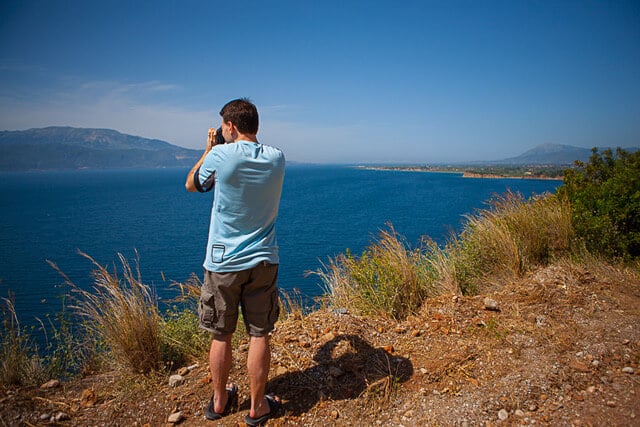
As you approach Delphi, the landscape becomes drier, with red rock and soil typical of the area. There are a number of hotels and restaurants in modern Delphi, and the archeological site is only a short drive away.
You can spend the afternoon exploring the ruins at Delphi, and if you are interested, the attached archeological museum. (As you may have noticed, every archeological site in Greece has an attached museum.) Delphi was supposedly the ancient centre of the world, and the site of Apollo’s oracle. And, like many ancient sites here, the Views. Are. Incredible.
A short walk away is the Sanctuary of Athena, a ruin which predates the Oracle.
Day 6 – Meteora
Meteora is easily the most fascinating and yet most under-appreciated tourist destination in Greece. It’s easy to see why it gets overlooked. It’s incredibly out of the way, a five hour drive heading North from Athens to central Greece (but also accessible by train!) It is a four hour drive from Delphi through narrow mountainous roads. But after our one night stay (and despite the cloudiness and rain the entire time), Daniel and I agreed that it was probably our favourite stop of the trip.

Meteora is a collection of medieval Eastern orthodox monasteries (now only six still functioning). But it is the location that is most astounding. The monasteries are all built on giant rock outcroppings in the mountains ((hence the name Meteora – “suspended in the sky”). The scenery and feat is otherworldly, not to mention its spiritual and historical value.
We stayed in Kastraki, the town right below the mountains.
We did our own self-drive to explore one of the monasteries in the afternoon, and took a tour (a “sunset tour”, but it was drizzling) in the early evening. My suggestion is if you are not driving (coming in by train), joining a tour is the perfect way to get around and explore Meteora. With a car and a guidebook, I feel Meteora can be easily done (and probably better appreciated) on your own.
Day 7
This is a travel day, driving back into Athens. While a long car-ride, this leg of the trip is all easy highway driving.
Return your car in Athens, and then take the bus (very accessible) down to Piraeus to being the island-hopping leg of the trip!
Most ferries depart early morning. There are many hotels in Piraeus catering toward early morning island-goers (including breakfast at 5am, as was the case with us).
Day 8 – 13 – Greek island hopping
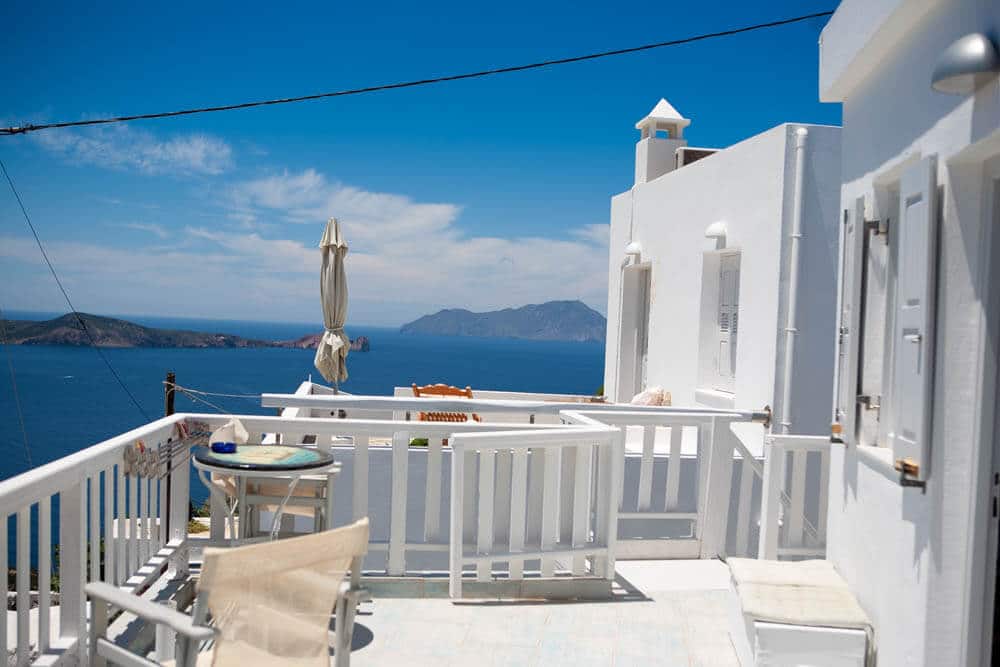
Greek islands.
There are so many to choose from. Where you *have* to go is only constrained by the ferry schedule. And keeping in mind that there is not always a ferry that goes from one island to the other (you may need to “transfer” at another island).
Logically, it makes sense to choose islands from the same “group” to minimize your travel time. On the other hand, a day’s travel on the slow ferry from one island to the other can be part of the adventure. As first time island-hoppers, we chose Milos and Santorini, islands in the Cyclades group. This group is both closest to the mainland, and contain the most well-known islands of the bunch – Santorini (possibly the most renowned and the most romantic), Mykonos (nightlife!), and Naxos (for the beaches).
I don’t think you can go wrong with any Greek island. We had a fabulous, balanced time between Milos and Santorini. Milos was much quieter and very relaxing, with out-of-this-word landscape. Santorini was vibrant, luxurious, romantic.
There are two types of ferries – the fast and the slow (which takes 2-3x longer). I would say the former is more like being on a plane, where the latter is more like a cruise ship. The fast ferry from Piraeus will get you to Santorini in 4 hours. It got us to Milos in 2.
We stayed in Milos for 3 days, and Santorini for 2. In Milos we rented a dune buggy to explore the island, hiked to the top of the island to watch sunset, and hit up a number of beaches. We also took a fantastic sailing tour around the island.
In Santorini, we stayed both nights in Oia, but in two very different style hotels. We meandered the streets, bought souvenirs, chased sunsets, and admired the views of the caldera. We enjoyed dining al fresco and luxuriated in our hotel pool.
The only island I wish we had time to explore was Crete. But we’ll save it for another time. The Greek islands is really an experience that needs to be savoured, not rushed. You will leave feeling relaxed, rejuvenated, and much lighter… like somewhere along the Aegean, you discovered Greece’s fabled fountain of youth.
Day 14
We left Santorini at the end of Day 13 by ferry, and arrived back in Piraeus by night. We spent the night in Piraeus. If your flight leaves in the evening, it is definitely possible to spend your last night on the island. You would need to take a ferry back to Piraeus in the morning. We try not to do too much traveling the day of our departure, as it really leaves no margin for error.
The next morning, the day of our flight, we took the express bus from Piraeus directly to the airport, concluding a remarkable adventure to Greece.
We hope you find this guide helpful, and inspires you to see and experience more of this stunning country. Have questions about our itinerary to Greece? Drop us a note!


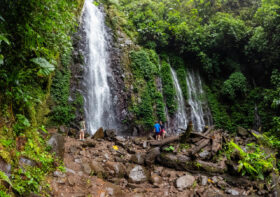

Sightseeing in Athens - the highlights - our everywhere view
[…] our 14 day Greece itinerary, we recommended seeing Athens in two days. Two days is enough to hit the highlights, with just the […]
The charming town of Nafplio and the Greek Peloponnese - our everywhere view
[…] town, settled into our hotel, had lunch, and then drove out to this site. As we mentioned in our 14 day itinerary of Greece, Epidaurus is known for two things: 1) the birthplace of ancient medicine, and 2) the giant theatre […]
Attraction spotlight: Ancient Olympia - our everywhere view
[…] we’ve recommended for all our Greece itinerary, we feel the best way to visit Olympia is by car, so you can see the site during off hours. You do […]
5 classic Greek dishes to try in Greece - our everywhere view
[…] And now the food! We had these 5 classic dishes again and again during our trip to Greece. We’ve attempted to make some variation of all these dishes, but there’s nothing like home-turf advantage when it comes to Greek food! (And if you’re planning a trip to Greece, don’t forget to check out our two week itinerary here!) […]